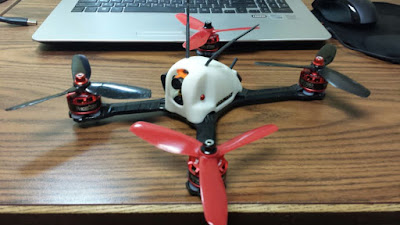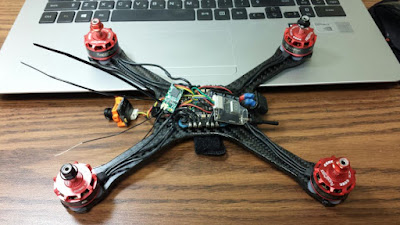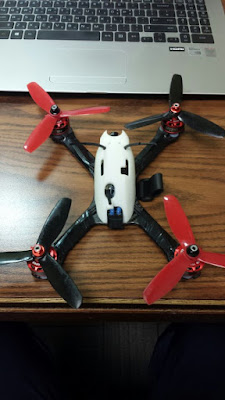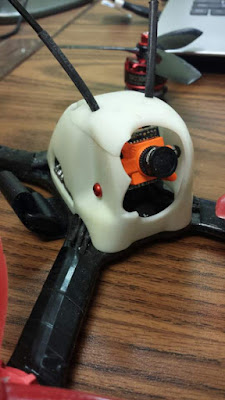Dynastinai - 3lb Modular Combat Robot
 |
| full of potential, but hampered by faulty drive system |
Dynastinai is my first attempt of building a battlebot with modular weapon system. It was greatly inspired by leading 3lb battlebots Silent Spring (link to Jamison's blog) and Margin of Safety (link to Aaron's blog). The name Dynastinai comes from dynastinae, which is a scientific name for rhinoceros beetle. I changed the letter "e" to "i" to respect the naming tradition of Robojackets Battlebot (all battlebot names end with letter "i"). Also, I thank Robojackets and its members for providing me the tools I needed and doing a design review for this project.
The modular weapon combat robot can be very effective in the competition because the driver can strategically choose which weapon to use against specific type of opponents. Depending of the types, battlebots are usually like rock, paper, scissors; one type of weapon is strong against certain weapon type, but is weak against another weapon type. For example, horizontal weapon is useful against many drum spinners with exposed vertical walls but is quite ineffective against wedges or vertical spinners with wedges at front since those deflect the horizontal hits. However, vertical spinner with two sharp prongs like the one designed above in the picture are effective against wedges or vertical spinners with wedges at front as those prongs put large pressure on to smaller area on the floor and this tend to dig under the wider wedges. This type of vertical spinner is at the same time, weak against horizontal spinners like the one designed above since those prongs are exposed to shear hits.
The goal of this project is to:
- build interchangeable weapon (one horizontal, one vertical)
- all basic structures made out of 3D printed materials
- compete in Motorama 2018
Parts I used for this build:
Aluminum parts on
chassis
|
6061 aluminum
|
Aluminum parts on
weapon modules
|
7075 aluminum
|
Wheel guard
|
HDPE
|
Chassis & vertical
module
|
carbon fiber + nylon
|
Horizontal module
|
Kevlar + nylon
|
Horizontal weapon
|
AR500
|
Vertical weapon
|
S7 tool steel
|
Drive Motors
|
maxon gearbox + 1806
brushless outrunner
|
Drive Motor
Controllers
|
ZTW Spider Lite 18A
opto
|
Wheels
|
Fingertech robotics
2.5in*0.75in neoprene foam wheels
|
Weapon Motor
(Horizontal)
|
Quanum MT 4108 700KV
|
Weapon Motor
(Vertical)
|
NTM 450 series 1700KV
|
Weapon Motor
Controllers
|
ZTW Spider 30A opto
|
Receiver
|
Frsky V8R4-II
|
Remote Control
|
Taranis QX7
|
Battery
|
3S 500mah 35C * 2 in
series
|
Connectors
|
XT30U, MR30
|
5V BEC
|
Pololu 5V 600mA
step-down regulator
|
12V BEC
|
TUZ 5V 12V 3A
step-down regulator
|
Standoffs
|
M3*35 aluminum column
spacer
|
| CAD - horizontal |
| CAD - vertical |
| CAD - internal view |
This is the bottom view. The top plate does not have to be removed at all unless it gets damaged. Only one bottom plate can be removed to access batteries and the other bottom plate can be also removed to access drive motors. The dove tail design of the module interface and the aluminum posts makes difficult to rip apart the module from the chassis in all directions.
| CAD - 3D printed chassis, electronics removed |
Aluminum standoffs are inserted into the 3D printed pieces. Top and bottom plates are then secured onto those standoffs with screws. This allows the top and bottom plates to clamp on the 3D printed parts and gives them compressive preload and prevents delamination. Screws and nuts hovering in the photo above are used to secure wheel guards on to the 3D printed chassis.
| Half section view of horizontal module |
No screws go through the 3D printed horizontal module. The aluminum pieces are clamped from top and bottom to give 3D printed part compressive preload: prevent delamination.
| Half section view of vertical module |
There are two bearings on each end of the vertical weapon. The motor is fully enclosed and is well protected inside.
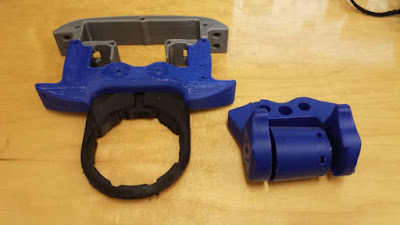 |
| Prototypes first before using expensive carbon fiber & kevlar |
 |
| 3D printing in action (horizontal module) |
 |
| completed part |
 |
| that's a lot of support structure to remove |
Vertical module is printed with its one side facing towards the bottom. This way, I could clamp the print layers sideways to prevent delamination.
 |
| CNC milling horizontal hub mount |
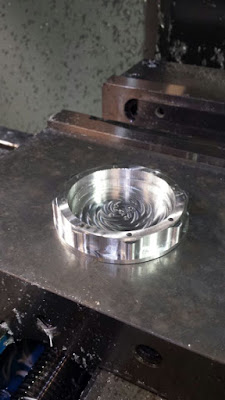 |
| Horizontal hub motor mount straight out of CNC mill |
Sadly, I didn't account for the tool deflection and the inner diameter where the bearing would sit was 0.002 inch smaller. The bearing would have still went in if I made a press fit but I didn't want that for the sake of easy maintenance. I used a dremel to carefully sand off the inner diameter little by little until the bearing could slide in with minimal interference.
 |
| chassis assembly almost complete |
On the vertical module, you can notice there are some nylon material extruded out and surrounding the vertical wedges. Without these, vertical wedges would be vulnerable to hits as it is just held by few M3 screws and it doesn't take a lot of force to shear those.
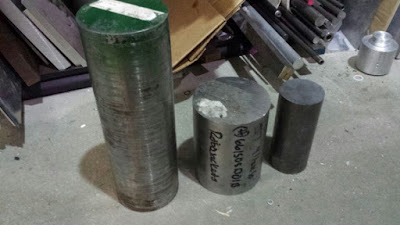 |
| Where else would you find S7 tool steel laying around up for grabs?? :) |
I was fortunate enough to find the S7 tool steel in the scrap pile in Robojackets shop. They weren't gonna be used by anyone and apparently, they have been laying around there for a while. So I cut a small piece off from one of them, made a request to the machining mall to have it lathed, wire EDMed, and then heat treated to make a vertical weapon.
 |
| Assembly almost complete. Stator on the vertical module is also machined and epoxy glued. |
 |
| Fabricated, with horizontal attachment |
Horizontal weapon was made out of 3/16 inch thick AR500 steel - waterjetted.
 |
| Bottom side |
Bottom cover is composed of two plates to easily access the internal components that are just needed. Also, too many screws on the horizontal weapon. I think I can reduce number of screws here for the next iteration.
 |
| With vertical attachment |
 |
| Internal view |
Inside is full of spaghetti. I couldn't optimize the wire length because I had to borrow drive motors and drive ESCs from other robojacket team members since I didn't have those.
 |
| I can take off this cover and access the drive motors |
The drive motors are composed of gearbox and brushless outrunner. Because of this, rooms for the outrunners to safely spin had to be designed. Here I clamped the gearbox (not spinning part of the drive motor) in an elevated position so that the outrunners have enough vertical space to spin. Also, a thin wall was made to prevent any wires from making contact with the outrunners.
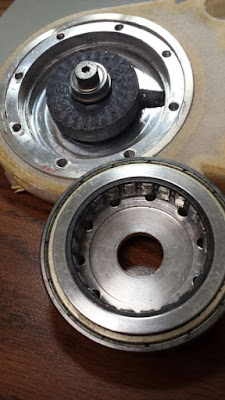 |
| Stator inside the motor mount (top), assembled motor hub (bottom) |
The stator is is machined to fit into the hub motor. Also, it is covered with thermally conductive but electrically insulating epoxy glue to be more resistant to heat and take impacts better when it makes contact with the magnets around it. The aluminum hub is first waterjetted for the holes and general dimension and then tuned on lathe for precise cuts. Magnet ring from the original motor is cut and press fitted into the hub and is covered with same epoxy glue to keep magnets in their place.
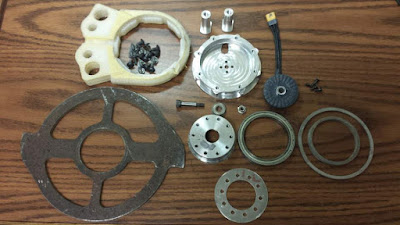 |
| horizontal module disassembled |
 |
| vertical module disassembled |
 |
| damage taken on the horizontal module during the rumble |
Even though the 3D printed part was clamped, delamination occured on the 3D printed part, and aluminum chunk was taken off from the hub motor mount. I will be strengthening this part in the future iteration.
 |
| damage on the right wheel guard |
 |
| damage on the left wheel guard |
HDPE wheel guards held pretty well. It covered majority portion of the 3D printed parts and the wheels and took almost all the hits. The damages to the wheel guards don't concern me since they are designed to be consumable and are cheap and easy to make (it takes 20 seconds to waterjet one).
Dynastinai testing its horizontal weapon
I see a lot of potential to this robot. There were many good aspect like the interchangeable weapons, efficient hub motor weapon, 3D printed chassis, 6 cell lipo battery. However, it was ultimately hampered by faulty drive system. Whenever I made sudden left to right movement or vise versa, the ESCs went into a reset mode and the robot was immobile until I put the control joystick at the center and wait for a second. In a fast paced, agility requiring combat arena, Dynastinai was immobile for significant period of time due to this mishap.
Not having my own drive system was a problem too. I had to borrow other Robojacket member's drive ESCs and motors so I had to spend significant amount of time taking the drive in and out instead of test driving or checking out if there are any other problems.
Also, I didn't put soft pads around the electronics inside so after hard hit from a vertical spinner, the weapon ESC got damaged and wouldn't spin up the motor anymore.
Dynastinai never won and its win loss ratio is 0:2 from Motorama 2018. However, now I know what to fix so hopefully I can build a more formidable combat robot (Dynastinai V2) in the future.
For future iteration of this robot, improvements would likely be:
- have my own, reliable drive system (brushless -> brushed motors?)
- less free space for soft mounting drive motor, use double sided foam tape or polyurethane rubber
- more space for the wheels to rotate
- 6 cell -> 4 cell lipo ? (this way I don't have to use separate voltage regulator to power drive system)
- smaller horizontal module's hub motor design (for increasing weapon reach distance)
- horizontal, vertical weapon design change to allow bi-directional rotation
- weapon ESC firmare upgrade to allow bi-directional motor rotation
- aluminum hub or 3D printed hub with high tolerance for vertical module's motor (reduce vibration)
- pad all electronics with foam for protection
